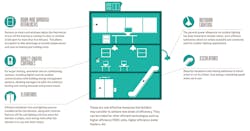New California Building Efficiency Standards Set the Stage for Zero Net Energy Homes by 2020
NRDC’s Meg Waltner explains California’s updated building energy efficiency standards and the state’s goal to create zero net energy homes.
The California Energy Commission voted unanimously this week to approve updated building energy efficiency standards that the CEC says will cut regulated energy use in new homes by 28 percent and save consumers $31 a month compared to houses built under the current energy code. The new standards also set the stage for zero net energy new homes in the state within five years.
Known as “Title 24,” the standards will go into effect on January 1, 2017, and set minimum energy-saving requirements for new buildings and renovations that will reduce energy used for lighting, heating, cooling, ventilation, and water heating.
With tens of thousands of homes built every year in California, the energy savings will add up to big environmental benefits: for buildings constructed and retrofitted in 2017 alone, the CEC found that standards will cut energy use by about 281 gigawatt hours of electricity and 16 million therms of natural gas per year, reducing harmful carbon dioxide pollution emissions by about 160,000 metric tons per year. After 30 years of construction, the CEC estimates that these savings will add up to the equivalent energy use of twelve large power plants.
One Step Closer to Zero Net Energy
The majority of the changes to the standards will apply to single-family and low-rise multifamily buildings. California has set goals that all new residential buildings will be zero net energy (ZNE) by 2020 and new commercial buildings will be ZNE by 2030. In general terms, a ZNE building is one that produces as much energy (generally through onsite renewable energy) as it consumes. Given that 2020 standards are right around the corner, the CEC chose to focus on improving the residential code and making modest improvements to the commercial code under the current update. Today’s standards are a great step toward meeting that 2020 goal.
The major residential energy savings measures include:
- High-performance walls: The standards would require increased wall insulation in most climate zones. These levels can be met with a variety of construction assemblies, including both 2×4 and 2×6 construction.
- High-performance attics: The standards give builders the options to either increase attic sealing and insulation or move ducts into conditioned space (either by installing a ductless system or placing ductwork in parts of the home that are already heated and cooled).
- High-performance lighting: The new standards will cut lighting energy in homes by almost half by requiring a high-efficacy bulb (such as a CFL or LED) in every socket. The standards also sets quality performance requirements to ensure that these bulbs meet consumer expectations. The standards provide builders flexibility by allowing screw-based bulbs for most socket-types.
- Water heating: The new standards require the use of an instantaneous tankless gas water heater, which saves energy by heating water on demand rather than storing it in a tank, or one with equivalent energy performance.
The major commercial energy-savings measures adopted today include:
Credit: California Energy Commission
- Increased building envelope requirements: The updated standards will require increased roof insulation in all climate zones and increased wall insulation in some climate zones.
- Improved lighting efficiency: The updated standards will require outdoor lighting to be more efficient and revise the indoor lighting power requirements for some space types to better align with the ASHRAE 90.1-2013 national model building standard.
- Elevators and escalator requirements: Updated requirements for elevators will require fans and lights to shut off when the elevator is unoccupied. Escalators and moving walkways will be required to reduce speed when not in use for extended periods of time.
- Interlocking controls: Buildings with operable windows will be required to have controls that shut off heating and cooling systems when a window is open for more than 5 minutes.
These are the major updates to the prescriptive requirements. Many builders choose to take the performance path which allows them to use whatever measures and construction practices they see fit to meet the overall energy target.
Looking Forward to 2019
Title 24 is updated every three years, which means that there is one only update left to achieve the ZNE target for new residential construction. Today’s standards take a big step toward meeting this goal, but there is still significant work to be done between now and 2020. Yesterday, the California Energy Commission and the California Public Utilities Commission jointly released a New Residential Zero Net Energy Action Plan that outlines the path to reaching residential ZNE in the next 5 years. Key strategies include building market awareness, establishing early adopter programs, increased efforts to ensure that the value of ZNE is recognized (through ratings and appraisals), and technical tools and trainings.
We commend the CEC for finalizing the new Title 24 standards today and the CEC and PUC for jointly outlining a path to get the rest of the way to our ZNE goal by 2020. Today’s standards add to the long history of success of Title 24, which has saved Californians over $30 billion on our energy bills since the 1970s.
This article orginally appeared on Switchboard, the Natural Resources Defense Council’s staff blog. Author Meg Waltner is NRDC manager, building energy policy, San Francisco, CA.







